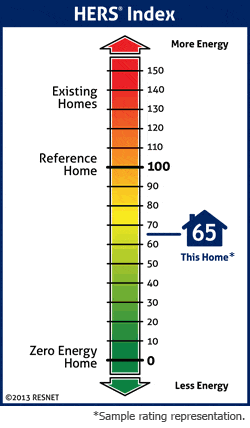What is a HERS score?
HERS is the industry standard for measuring a home’s energy efficiency. Developed by the Residential Energy Services Network (RESNET), HERS is short for Home Energy Rating System. Similar to Miles Per Gallon (MPG), it is a great selling point to attract more home buyers. Unlike MPG where a higher score is better, with HERS, a lower score is better for the buyer. The way it works is pretty simple. But, I know you’re wondering why does it matter and what does it even have to do with me?
Why a HERS Score is Important
Today, there are over 2 million homes that have a HERS rating. In 2016 alone, over 206,000 homes received a HERS-rating. Which means, if your home isn’t receiving one, there is a high chance that your competitor’s homes are.
Similar to golf, the lower the score, the better. For a HERS score, a lower score is very ideal because it means that your home is more energy efficient than your competitor’s home. The more energy efficient a home is, the lower the electricity bills are for the homeowner.
The Benefits of a HERS Score
Reduced energy bills are just one of the many benefits that new homeowners will experience with a low HERS score. Additional benefits include:
- Understanding the true cost of home ownership;
- Higher home resale value; and
- Increased home comfort.
How scores are decided
Scores range on a scale of 0 to 150. The typical resale home averages a score of about 130, which means, this house is at least 30% less energy efficient than a 2006 IECC home. Therefore, the homeowner will experience higher energy bills than if they purchase a home with a HERS Index of 50.
To help put this score into perspective; if you were to build a home with a score of 50, the home you sell is 50% more energy efficient than a home built to the 2006 code and 80% more efficient than the average resale home.
In 2016, the Average HERS Index score was 61. This means that today, homes are 39% more energy efficient than in 2006 and 69% more energy efficient than in the 1970s.
A few variables that are assessed when assigning a HERS score include:
- Exterior walls;
- Floors over unconditioned spaces (like garages and cellars);
- Ceilings and roofs;
- Attics, foundations, and crawlspaces;
- Windows and doors;
- Vents and ductwork;
- HVAC systems;
- Water heating system; and
- Performance testing including blower door and duct blaster testing.
Below is a scale to show you how homes can perform. For a more in depth look, view the description of scores on RESNET’s website.

Building a HERS rated home
Achieving a HERS score lower than your competitor is possible. There are numerous certification programs like ENERGY STAR and ecoSelect that can guide you down a path to energy efficiency. In addition, adding premium features like solar can also drive down HERS scores into the “net zero” range.
Achieving a low HERS score isn’t expensive. In fact, there are many cost effective ways to achieve low HERS score. Builders may be eligible for numerous utility, state, and federal incentives for building green. Southern Energy Management previously covered a number of ways that you can earn cash back for building to a certain level of energy efficiency. Building to higher standard is easier now than ever. With the help of a third party HERS rater, you’ll be all set to go.
Find out what tools you need to get you on track to achieve a low HERS score.














